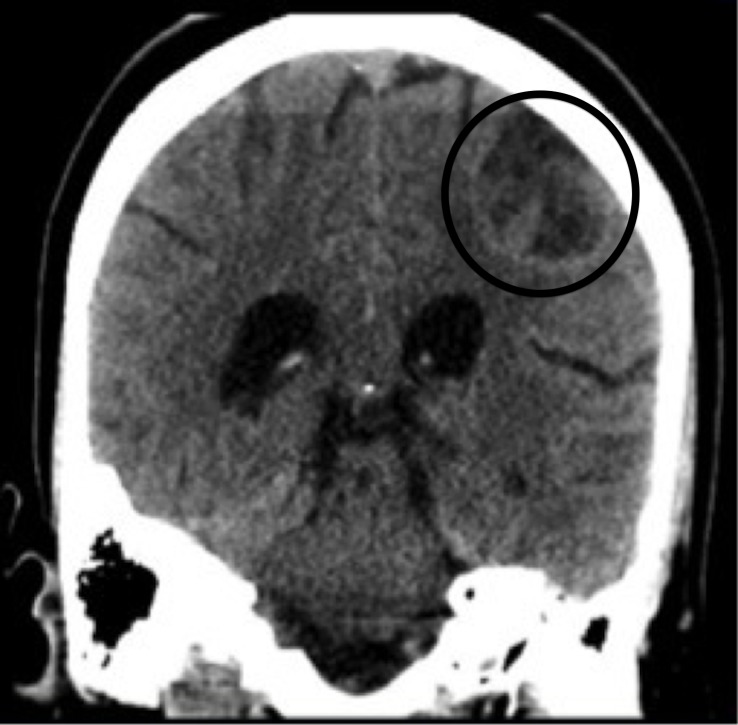| Author | Affiliation |
|---|---|
| Thomas M. Nappe, DO | Lehigh Valley Hospital-Muhlenberg, Department of Emergency Medicine, Bethlehem, Pennsylvania |
| Matthew T. Niehaus, DO | Lehigh Valley Hospital-Muhlenberg, Department of Emergency Medicine, Bethlehem, Pennsylvania |
| Terrence E. Goyke, DO | Lehigh Valley Hospital-Muhlenberg, Department of Emergency Medicine, Bethlehem, Pennsylvania |
A 26-year-old female presented to the emergency department with a chief complaint of dizziness. Further history revealed that she was experiencing generalized weakness and intractable vomiting for three days, without complaint of abdominal pain or lower gastrointestinal symptoms. Physical examination uncovered mild dehydration with stable vital signs and non-fatigable, horizontal nystagmus consistent with internuclear opthalmoplegia. Computed tomography of her brain was ordered and revealed an “open ring sign” as displayed in the figure.

The “open ring sign,” or open ring enhancement of a lesion on neuroimaging, has been found to be highly specific for demyelinating diseases and can help differentiate them from malignant and infectious neurological disorders, where ring enhancement is more often closed.1-2 The open ring is typically crescent-shaped and open to the basal ganglia or, as in our patient, the cortex, with the enhanced area resembling acutely inflamed white matter while the unenhanced area resembles more chronic inflammation.1 A retrospective case series has found that open ring enhancement has a specificity of 84.4–93.8% for demyelinating conditions, with a likelihood ratio of 5.2 and 17.2 for demyelination over malignancy and infection, respectively.1-2 In our patient, a demyelinating condition was suspected based on this image, and the diagnosis of multiple sclerosis was ultimately confirmed by the presence of oligoclonal bands on cerebrospinal fluid analysis.
Footnotes
Section Editor: Sean O. Henderson, MD
Full text available through open access at http://escholarship.org/uc/uciem_westjem
Address for Correspondence: Thomas M. Nappe, DO, Lehigh Vally Hospital-Muhlenberg, Department of Emergency Medicine, 5th Floor, South Wing, Bethlehem, PA 18017. Email: tom.nappe@gmail.com. 7 / 2015; 16:579 – 780
Submission history: Revision received April 18, 2015; Accepted April 25, 2015
Conflicts of Interest: By the WestJEM article submission agreement, all authors are required to disclose all affiliations, funding sources and financial or management relationships that could be perceived as potential sources of bias. The authors disclosed none.
REFERENCES
1. De Medeiros FC, De Albuquerue LAF, Pittella JE, et al. Open-Ring Enhancement in Pseudotumoral Multiple Sclerosis: Important Radiological Aspect. Case Rep Neurol Med. 2014. Available at: http://dx.doi.org/10.1155/2014/951690. Accessed Apr 16, 2015.
2. Masdeu JC, Quinto C, Olivera C, et al. Open-ring imaging sign: highly specific for atypical brain demyelination. Neurology. 2000;54:1427-33. Available at: http://www.neurology.org/content/54/7/1427.full.pdf+html. Accessed Apr 16, 2015.


